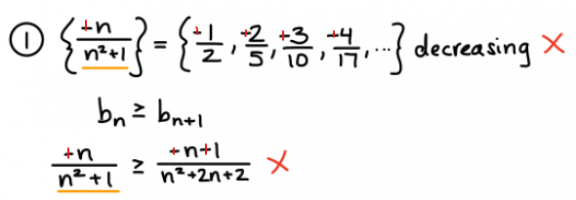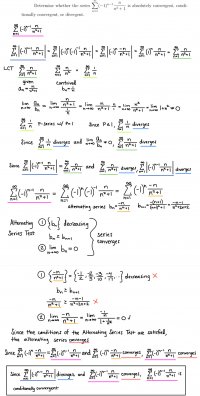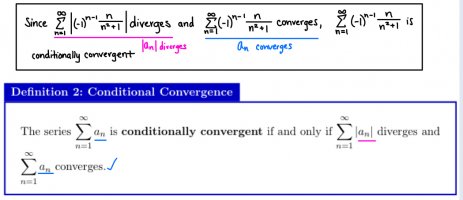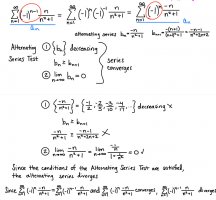You are using an out of date browser. It may not display this or other websites correctly.
You should upgrade or use an alternative browser.
You should upgrade or use an alternative browser.
Proving a Series Conditionally Converges
- Thread starter I Love Pi
- Start date
pka
Elite Member
- Joined
- Jan 29, 2005
- Messages
- 11,978
The alternating series test. Read that link.
The link you attached confirms what I applied in my attempt at the problem, however, I am still confused on why the Alternating Series Test failed and how to correct this.
Attachments
BeachBanana
Senior Member
- Joined
- Nov 19, 2021
- Messages
- 2,281
The link you attached confirms what I applied in my attempt at the problem, however, I am still confused on why the Alternating Series Test failed and how to correct this.

Your [imath]b_n[/imath] should just be [imath]\frac{n}{n^2+1}[/imath] without the minus. To show the sequence is decreasing, consider the function [imath]f(x)=\frac{x}{x^2+1},x>1[/imath]. Take the derivative and determine whether the function is decreasing or increasing for [imath]x>1[/imath].
Last edited:
pka
Elite Member
- Joined
- Jan 29, 2005
- Messages
- 11,978
Alternating_series_test: If [imath]a_1\ge a_2\ge a_3\cdots a_n\ge \cdots\ge 0[/imath]
such that [imath]\left(a_n\right)\to 0[/imath] then the series [imath]\displaystyle\sum\limits_{n = 1}^\infty {{{( - 1)}^n}{a_n}} [/imath] converges.
In common parlance: if the sequence part of an alternating series is a decreasing to zero the series converges.
Can you explain why you think that does not apply here?
such that [imath]\left(a_n\right)\to 0[/imath] then the series [imath]\displaystyle\sum\limits_{n = 1}^\infty {{{( - 1)}^n}{a_n}} [/imath] converges.
In common parlance: if the sequence part of an alternating series is a decreasing to zero the series converges.
Can you explain why you think that does not apply here?
Dr.Peterson
Elite Member
- Joined
- Nov 12, 2017
- Messages
- 16,870
You appear to be forgetting to take the absolute value of each term. You are using negative [imath]b_n[/imath]:The link you attached confirms what I applied in my attempt at the problem, however, I am still confused on why the Alternating Series Test failed and how to correct this.

Note the absolute values here:
Alternating series test
A series of the form [imath]\displaystyle \sum _{n=0}^{\infty }(-1)^{n}a_{n}=a_{0}-a_{1}+a_{2}-a_{3}+\cdots[/imath] where either all an are positive or all an are negative, is called an alternating series.
The alternating series test guarantees that an alternating series converges if the following two conditions are met:
- [imath]\displaystyle |a_{n}|[/imath] decreases monotonically, i.e., [imath]\displaystyle |a_{n+1}|\leq |a_{n}|[/imath], and
- [imath]\displaystyle \lim _{n\to \infty }a_{n}=0[/imath]
(Note: I attempted to prove the summation is conditionally convergent using the following theorem.)Alternating_series_test: If [imath]a_1\ge a_2\ge a_3\cdots a_n\ge \cdots\ge 0[/imath]
such that [imath]\left(a_n\right)\to 0[/imath] then the series [imath]\displaystyle\sum\limits_{n = 1}^\infty {{{( - 1)}^n}{a_n}} [/imath] converges.
In common parlance: if the sequence part of an alternating series is a decreasing to zero the series converges.
Can you explain why you think that does not apply here?
I noticed that the the series is not (-1)^n , but (-1)^(n-1). Is this discrepancy why the Alternating Series Test does not apply? If the Alternating Series Test can’t be applied, how else could I prove the summation of An converges (and therefore prove the summation of An is conditionally convergent)?
Attachments
Dr.Peterson
Elite Member
- Joined
- Nov 12, 2017
- Messages
- 16,870
No, the alternating series test does apply! You are just applying it incorrectly because of the difference you point out.I noticed that the the series is not (-1)^n , but (-1)^(n-1). Is this discrepancy why the Alternating Series Test does not apply?
Do you not see that you can just pull a -1 outside of the entire summation? You need to ensure that what you call bn are positive (or else, as the Wikipedia statement of the test does, let them all be negative, as you did, but compare their absolute values).
See this lesson, which includes examples with different exponents on the (-1):
Calculus II - Alternating Series Test
In this section we will discuss using the Alternating Series Test to determine if an infinite series converges or diverges. The Alternating Series Test can be used only if the terms of the series alternate in sign. A proof of the Alternating Series Test is also given.
tutorial.math.lamar.edu
Or you can show us the exact formulation of the test you were taught, and we can explain how you are misunderstanding it.






